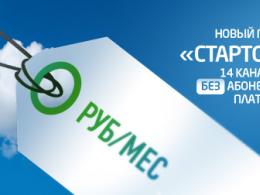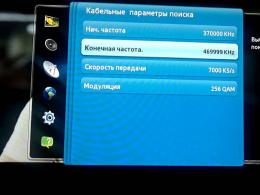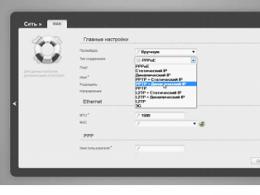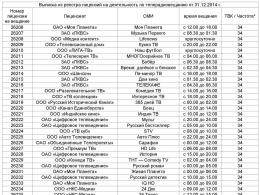Digital TV 3 multiplex when they launch. What will the third digital TV multiplex offer viewers
Growing rumors about testing a third multiplex with additional free digital channels do not fade away. The planned transition was supposed to take place as early as that year, but in reality only 20 channels are available to viewers. This is not surprising, the first package of channels was put into operation almost 10 years ago. The second was tested for 3 years before it became publicly available.
Now all residents of Moscow can evaluate the 3rd multiplex. However, in fact, it most likely should appear at the end of 2019 or the beginning of 2020. New details, as well as about the list of channels that are going to get into it, we will tell today.
Which channels are most likely to get into the third multiplex

It is too early to talk about it, but there are rumors about those TV channels that are likely to top the list of the new package. There are currently about 40 candidates in total. You can see them in the table above.
You can watch these channels at the designated broadcast time. To search, you must use channel 34 at a frequency of 578 MHz.
Do you know that in Rep. Crimea has its own 3 multiplex. It includes several republican channels
When selecting candidates, RTRS and Roskomnadzor take into account the following requirements:
- Possibility of round-the-clock broadcasting.
- The absence of financial problems for the channel and possible difficulties with provision in the future.
- General popularity among the population.
- Broadcasts of original content.
- Possibilities of analog broadcasting.
The introduction of a multiplex is complicated for a number of reasons. Firstly, the requirements of the population do not always coincide with the criteria cited by Roskomnadzor. In particular, not all desired channels have the capacity to broadcast on analog frequencies. Secondly, due to the size of the country, it is difficult to assess the financial benefits of both parties.
That is why a new package of channels is selected and mastered for a very long time. We hope that this process will be completed by the end of the year, because by June 3 the last region will be disconnected from analogue broadcasting.
The third digital television multiplex in Russia in its original version assumed the presence of one HD channel, one regional channel from the All-Russian State Television and Radio Broadcasting Company and regional channels belonging to different regions.
Broadcasting of the third multiplex will be carried out by FSUE RTRS in the DVB-T2 standard throughout Russia on the principles approved by the meeting of the Government Commission for the Development of Television and Radio Broadcasting on December 17, 2010. The third multiplex is formed from:
- from 4 regional TV channels in standard definition format (SDTV)
- one federal all-Russian TV channel in high definition format (HDTV).
The channels were to be determined on a competitive basis. Regional TV and radio companies participating in the competition may attract federal TV and radio broadcasting organizations that are not included in the network as network partners.
Basic principles for selecting channels for the third multiplex:
- round the clock broadcasting;
- broadcasting concept;
- the presence of a larger volume of programs of own production and / or purchased programs;
- degree of interest in the TV channel;
- the financial position of the company;
- availability of active broadcasting in the analog standard;
- the social significance of the channel.
However, now, the concept has changed and the third digital television multiplex in Russia will include channels that could not enter the first two. So, the following channels can apply for membership in the third multiplex: Dozhd, Russia Today, Friday, 2×2 and others. The final decision on the third multiplex will be made by a government commission.
At the SPEKTR-2013 conference, details about the third digital television multiplex were announced. According to a representative of the RTRS, the third multiplex will be predominantly federal. The preliminary plan for its composition is 10 channels of standard definition (SD), 7-8 federal, 1-2 regional and one channel will be transferred to VGTRK. High-definition (HD) channels are not planned in the third digital TV multiplex in Russia.
So far, one channel has been determined, which will enter the third multiplex. It will be created by the branches of the Federal State Unitary Enterprise All-Russian State Television and Radio Broadcasting Company for each specific subject of the Russian Federation. The TV channel will be formed under a single brand and comply with the information policy of VGTRK. In regions where there are no large branches of the Federal State Unitary Enterprise VGTRK or there is no possibility to form a channel by the VGTRK, local regional TV channels can be involved in broadcasting.
It is not yet clear when the third multiplex will be launched, but according to the announced plan of the Russian government on the transition to digital television, its launch should take place before the end of 2015.
At this stage of development of digital terrestrial TV 3 multiplex is already broadcasting in Moscow

It includes the first and second all-Russian channels broadcasting in high definition HDTV, as well as channels: RU TV, CTC love, RBC, Moscow 24, and two local channels.
Now almost all residents of the country have access to 20 digital channels of Russian television, and plans are underway to launch a third multiplex. However, there is no official data on the start of the broadcast, and some sources claim that it will start working after the analog broadcast is stopped. The information below will help reveal the details of the 3rd multiplex: when it will be launched, which TV channels will broadcast, etc.
Third multiplex

Today, two digital TV multiplexes are officially operating in Russia. Each digital package includes 10 federal and regional programs on various topics. This is due to the limitation of the amount of packet data that can be broadcast in the T-2 (DVB-T2) standard on one frequency and received on one physical TVK.
The third multiplex is included in the plans for the development of digital TV in Russia. However, there is no official data on the start of its work, and the planned launch date has not been set. In practice, broadcasting is already underway from the Ostankino TV tower and the 3rd package of TV channels is available to all residents of the Moscow region. At the moment it is the only source of the third package of digital TV in Russia and not a single repeater has been installed yet.
The main problems of the development of the 3rd multiplex
The launch of the third package requires support for the same technologies as the first 20 TV channels, and its distribution could potentially begin at any time. At the same time, at the moment there are restrictions that are slowing down factors:
- Analog broadcast. Standard terrestrial broadcasting occupies the entire meter range of waves, and decimeter is not enough to broadcast 30 programs throughout the territory. Today, many TV channels are planning to stop analogue broadcasting, but there is no single program, and the frequencies are slowly freed up. This problem is complicated by the presence of regional and city TV channels.
- Forming a list of programs. At the moment, Roskomnadzor has issued a license for broadcasting in the 3rd multiplex to more than 40 television and radio companies, which will be included in the list of channels of the third package. Residents of the Moscow region already know them, but the list of programs for broadcasting is still not completed in the regions.
Without resolving these issues, the distribution of the 3rd package of channels in Russia is considered unprofitable.
Channels of the 3rd digital TV package
The first two packages of digital TV channels are mainly represented by federal programs with round-the-clock broadcasting. The third multiplex is planned to include local channels, ie. each region will have its own set of television programs. For Moscow, this list has already been approved. The table below shows a list of TV channels of the 3rd digital television multiplex, which can now be received by residents of the capital and neighboring districts.
| Position | Name | Number | Frequency, MHz | Broadcast time, h/week |
| 1 | Sport 1 | 34 | 578 | around the clock |
| 2 | Sports 2 | 34 | 578 | 00:00-06:00 (42) |
| Fight club | 34 | 578 | 06:00-12:00 (42) | |
| My planet | 34 | 578 | 12:00-18:00 (42) | |
| Science 2.0 | 34 | 578 | 18:00-00:00 (42) | |
| 3 | Russian novel | 34 | 578 | 00:00-05:00 (35) |
| Russian bestseller | 34 | 578 | 05:00-10:00 (35) | |
| Russian detective | 34 | 578 | 10:00-15:00 (35) | |
| Story | 34 | 578 | 15:00-20:00 (35) | |
| cartoon | 34 | 578 | 20:00-00:00 (35) | |
| 4 | Sundress | 34 | 578 | 00:00-12:00 (84) |
| The country | 34 | 578 | 12:00-00:00 (84) | |
| 5 | living planet | 34 | 578 | 00:00-06:00 (42) |
| IQ HD (SD quality) | 34 | 578 | 06:00-09:00 (21) | |
| 24 Doc | 34 | 578 | 09:00-12:00 (21) | |
| Techno 24 | 34 | 578 | 12:00-15:00 (21) | |
| Mum | 34 | 578 | 15:00-18:00 (21) | |
| NST | 34 | 578 | 18:00-21:00 (21) | |
| Amusement park | 34 | 578 | 21:00-00:00 (21) | |
| 6 | Moscow. Confidence | 34 | 578 | 00:00-12:00 (84) |
| euronews | 34 | 578 | 12:00-00:00 (84) | |
| 7 | Music of the First | 34 | 578 | 08:30-01:30 (119) |
| Home Cinema | 34 | 578 | 01:30-02:30 (7) | |
| Time | 34 | 578 | 02:30-04:30 (14) | |
| telecafe | 34 | 578 | 04:30-06:30 (14) | |
| Beaver | 34 | 578 | 06:30-08:30 (14) | |
| 8 | 365 days TV | 34 | 578 | 00:00-02:00 (14) |
| TNT-Comedy | 34 | 578 | 02:00-04:00 (14) | |
| Lots of TV | 34 | 578 | 04:00-06:00 (14) | |
| HD Life (SD quality) | 34 | 578 | 06:00-08:00 (14) | |
| STV | 34 | 578 | 08:00-10:00 (14) | |
| India TV | 34 | 578 | 10:00-12:00 (14) | |
| Fighter | 34 | 578 | 12:00-14:00 (14) | |
| Comedy TV | 34 | 578 | 14:00-16:00 (14) | |
| La Minor | 34 | 578 | 16:00-18:00 (14) | |
| Male cinema | 34 | 578 | 18:00-20:00 (14) | |
| Kitchen TV | 34 | 578 | 20:00-22:00 (14) | |
| Auto Plus | 34 | 578 | 22:00-00:00 (14) | |
| 9 | lifenews | 34 | 578 | around the clock |
| 10 | Our football | 34 | 578 | blocked |
As you can see, there are 40 channels in total, but most do not have round-the-clock broadcasting. The total amount of broadcast time is comparable to the round-the-clock broadcast of 10 channels, which corresponds to the volume of the other two multiplexes.
The list of these channels has not yet been fully approved, and it is not known whether it will be exactly the same for digital TV in Russia before the official release of the 3rd package. However, all active (indicated in the table) channels already have a broadcasting license dated 12/31/2014.
Broadcast frequencies
The third package of digital TV channels will broadcast on the same principle as the first two. All programs will be broadcast on one physical TV channel (TVK) at a specific frequency. For the Moscow region, the third package is broadcast at a frequency of 578 MHz, which corresponds to 34 TVK. However, it is not approved and is subject to change.
There are no reserved broadcast frequencies for the regions yet, because the problem of its choice is associated with a large number of regional programs.
Multiplex release history
 In the summer of 2009, by Presidential Decree, the implementation of digital television began with the broadcasting of the DVB-T2 standard, for which the frequency range 470 - 862 MHz was allocated. At the same time, the 1st digital television multiplex appeared and began to broadcast. It included all federal channels, the broadcasting of which at that time operated on analogue air:
In the summer of 2009, by Presidential Decree, the implementation of digital television began with the broadcasting of the DVB-T2 standard, for which the frequency range 470 - 862 MHz was allocated. At the same time, the 1st digital television multiplex appeared and began to broadcast. It included all federal channels, the broadcasting of which at that time operated on analogue air:
- First,
- Russia 1,
- Match TV,
- Channel Five (Petersburg),
- Russia-K,
- Russia 24,
- Carousel,
- TVC (TV Center).
The distribution of the 1st package happened quickly and by 2010 more than 90% of the country's inhabitants could use free digital terrestrial television.
The launch of the second package of digital TV began in 2012, but did not receive such rapid distribution as the first package. This is due to the fact that part of the air was provided to regional television companies, which are numerous throughout the country. Obtaining a license by each local TV channel in general took a long time and was held on a competitive basis. Today, almost all residents have access to the 2nd multiplex and a total of 20 digital TV channels. The following channels of the second package are available in Moscow:
- REN TV,
- SAVED,
- Home,
- Friday!,
- Star,
- Muz TV.
They are broadcast at a frequency of 498 MHz, which corresponds to 24 TVK.
The exact date of the 3rd digital television multiplex is unknown. The broadcast is scheduled for 2019, at the same time as the analogue broadcast is switched off.
However, it is known that all channels will be represented by local broadcasting and its appearance of the third package depends on regional companies. It is also planned that the channels of the third multiplex will occupy the analogue broadcasting frequencies of the former programs. In particular, to select programs in the Moscow region, Roskomnadzor held an open competition, and the issuance of licenses lasted a whole year.
3 , average rating: 3,33
out of 5)
A multiplex is a set of channels that are broadcast as a single information stream and is available to viewers for free. Today, almost all territories of the Russian Federation are covered by two multiplexes. 3 digital TV package is in development and should be launched in the next few years.
Multiplexes currently available
Free digital TV at the moment in the Russian Federation it is represented by two packages of RTRS, with the exception of Moscow and the Republic of Crimea - three multiplexes already operate there.
The package included all the federal TV and radio stations that were broadcast at that time in an analog format. It also included 3 radio channels: Radio Russia, Vesti FM, Mayak.

Launched in 2013 second free TV package, but it did not spread immediately. Firstly, initially it was free only for viewers, while channels paid operators for broadcasting. Since both digital and analogue broadcasts were carried out at the same time, the TV channels had financial difficulties, which slowed down the process. As a result, in 2015, the state applied the Must Carry principle to the package, according to which operators are supposed to broadcast these channels for free. Secondly, regional television companies are responsible for part of the broadcast of the second multiplex, so it took a long time for local broadcasters to pass the competition and receive licenses.

In the Republic of Crimea Package 3 has been broadcasting since 2014. It is represented mainly by local broadcasters:
- First Crimean;
- Information channel of Sevastopol;
- World 24;
- Moscow 24;
- Millet;
- First Crimean HD;
- Crimea 24 HD.
Important! In the city of Sevastopol, the First Sevastopol additionally broadcasts.
Moscow residents 3 digital TV multiplex is also available. It was launched in test mode from the Ostankino television tower in early 2015. Like the first two, it includes 10 positions, but they are distributed in a non-standard way. They were divided among 40 broadcasters, each of them has its own air time.




Thus, 30 channels of digital terrestrial television are already available to residents of Moscow free of charge.
What channels will be included in the third multiplex
It was originally planned that the third digital television multiplex in Russia would be: 1 channel in HD, 1 regional TV channel produced by VGTRK and four regional channels from different regions. However, the concept has changed over the years. In 2013, it was decided that set 3 would include 10 TV channels in SD quality:
- 7-8 federal;
- 1-2 from regions;
- 1 from VGTRK.
To create the third set, they were going to involve TV channels that were not included in the second: 2x2, Rain, Friday and others.
It is currently planned that channels 3 of the multiplex will be predominantly regional. They will be selected on a competitive basis. The main selection principles are:
- the possibility of round-the-clock broadcasting;
- percentage of self-produced content;
- audience interest in the channel;
- concept;
- financial well-being;
- the social significance of the channel.
When is it planned to launch 3 multiplexes
Initially, the launch of the third multiplex was scheduled for 2015, but then its broadcasting started only in Moscow and the region. The launch in other regions has been repeatedly postponed, and today its exact date is unknown. Most likely, the 3rd package will be launched in 2019-2021.
Since the 3rd set is to consist predominantly of regional malls, it is likely that it will be launched only in some regions. Namely, where local TV and radio companies are willing to pay RTRS for broadcasting services. We are talking about amounts from 100 to 400 million rubles. Obviously, not every region can afford it, since not everywhere there are 10-15 local shopping malls that share the payment among themselves, in many subjects of the Russian Federation there are only 1-2 shopping malls, and it is not profitable for them to pay the entire amount.
So, today it is still not clear when exactly the 3rd set of digital TV will appear throughout the Russian Federation, but this should happen in the near future.
In January 2015, the third multiplex began broadcasting from the capital's Ostankino TV tower in trial mode. The launch is associated with the active introduction of digital television in our country. To continue watching channels, it is enough to make changes to the TV settings: operating frequency 578 MHz, TVK number 34, DVB-T2 standard. The resource for 10 positions was distributed in an unusual way for Russian broadcasting. Roskomnadzor has issued a license to 40 TV channels, but they work alternately with a certain schedule: each has a certain time to go on the air. The main reason why the broadcast is not carried out in full is the new Federal Law “On Advertising”. It banned advertising on paid or encrypted channels, and free-to-air broadcasting is needed to get out of this restriction. Even if the program was shown for one or two hours a day, it has the right to include advertising in its entirety in the allotted time. Below are the positions, and the broadcast schedule of the channels with the time indicated.
| Position | Channel logo | Name | Number | Frequency | Broadcast time |
|---|---|---|---|---|---|
| 1 | 34 | 578 MHz | around the clock | ||
| 2 | 34 | 578 MHz | 00:00-06:00 (42 hours/week) | ||
| 34 | 578 MHz | 06:00-12:00 (42 hours/week) | |||
| 34 | 578 MHz | 12:00-18:00 (42 hours/week) | |||
| 34 | 578 MHz | 18:00-00:00 (42 hours/week) | |||
| 3 | 34 | 578 MHz | 00:00-05:00 (35 hours/week) | ||
| 34 | 578 MHz | 05:00-10:00 (35 hours/week) | |||
| 34 | 578 MHz | 10:00-15:00 (35 hours/week) | |||
| 34 | 578 MHz | 15:00-20:00 (35 hours/week) | |||
| 34 | 578 MHz | 20:00-00:00 (35 hours/week) | |||
| 4 | 34 | 578 MHz | 00:00-12:00 (84 hours/week) | ||
| 34 | 578 MHz | 12:00-00:00 (84 hours/week) | |||
| 5 | 34 | 578 MHz | 00:00-06:00 (42 hours/week) | ||
| IQ HD (SD quality) | 34 | 578 MHz | 06:00-09:00 (21 hours/week) | ||
| 34 | 578 MHz | 09:00-12:00 (21 hours/week) | |||
| 34 | 578 MHz | 12:00-15:00 (21 hours/week) | |||
| 34 | 578 MHz | 15:00-18:00 (21 hours/week) | |||
| 34 | 578 MHz | 18:00-21:00 (21 hours/week) | |||
| 34 | 578 MHz | 21:00-00:00 (21 hours/week) | |||
| 6 | 34 | 578 MHz | 00:00-12:00 (84 hours/week) | ||
| 34 | 578 MHz | 12:00-00:00 (84 hours/week) | |||
| 7 | 34 | 578 MHz | 08:30-01:30 (119 hours/week) | ||
| 34 | 578 MHz | 01:30-02:30 (7 hours/week) | |||
| 34 | 578 MHz | 02:30-04:30 (14 hours/week) | |||
| 34 | 578 MHz | 04:30-06:30 (14 hours/week) | |||
| 34 | 578 MHz | 06:30-08:30 (14 hours/week) | |||
| 8 | 34 | 578 MHz | 00:00-02:00 (14 hours/week) | ||
| 34 | 578 MHz | 02:00-04:00 (14 hours/week) | |||
| 34 | 578 MHz | 04:00-06:00 (14 hours/week) | |||
| HD Life (SD quality) | 34 | 578 MHz | 06:00-08:00 (14 hours/week) | ||
| STV | 34 | 578 MHz | 08:00-10:00 (14 hours/week) | ||
| 34 | 578 MHz | 10:00-12:00 (14 hours/week) | |||
| 34 | 578 MHz | 12:00-14:00 (14 hours/week) | |||
| 34 | 578 MHz | 14:00-16:00 (14 hours/week) | |||
| 34 | 578 MHz | 16:00-18:00 (14 hours/week) | |||
| 34 | 578 MHz | 18:00-20:00 (14 hours/week) | |||
| 34 | 578 MHz | 20:00-22:00 (14 hours/week) | |||
| 34 | 578 MHz | 22:00-00:00 (14 hours/week) | |||
| 9 | 34 | 578 MHz | around the clock | ||
| 10 | 34 | 578 MHz | blocked |
The information was obtained from open sources and is current at the beginning of 2020. As the grid changes, the data will be updated.
Article 37. Erotic publications
×Law of the Russian Federation of December 27, 1991 N 2124-1 (as amended on July 13, 2015)
"About the media"
Distribution of releases of specialized radio and television programs of an erotic nature without signal coding is allowed only from 23:00 to 04:00 local time, unless otherwise established by the local administration.
For the purposes of this Law, a media outlet specializing in messages and materials of an erotic nature means a periodical or program that generally and systematically exploits the interest in sex.
Retail sale of media products specializing in messages and materials of an erotic nature is allowed only in sealed transparent packages and in specially designed premises, the location of which is determined by the local administration.






